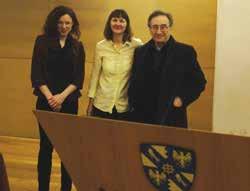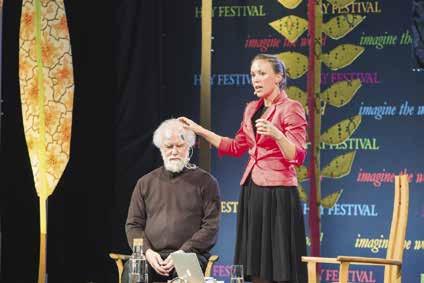
14 minute read
Good discourse among the old men – of Islands now and then rising
‘GOOD DISCOURSE AMONG THE OLD MEN – OF ISLANDS NOW AND T H E N R I S I N G A N D FA L L I N G AGAIN IN THE SEA’:
SAMUEL PEPYS AND FANTASTICAL ISLES
Advertisement
The College is fortunate to own Volume II of the influential first edition of Gulliver’s Travels by Jonathan Swift, which was printed in two volumes for Benjamin Motte in 1726. The narrative recounts Lemuel Gulliver’s fateful voyage as a sea captain: he is abandoned on a mysterious island by his treacherous crew, who conspire to follow a new career as pirates 1 . He finds himself in the land of the Houyhnhnms – a race of civilised and cultured horses. Our delightful edition offers a map purporting to show the island, marked ‘Discovered AD 1711’ (Fig 1). Over time, Gulliver learns about, and comes to respect, his hosts and their society: ‘I had not been a Year in this Country, before I contracted such a Love and Veneration for the Inhabitants, that I entered on a firm resolution never to return to human Kind, but to pass the rest of my Life among these admirable Houyhnhnms in the Contemplation and practice of every Virtue.’ The more he learns of the gentle equines, the more Gulliver grows aware of the failings of his native Britain. The volume quickly turns to satire. Lawyers, doctors and politicians are especially derided in comparison with the noble horses of the island.
Figure 1
1 Magdalene Old Library C.5.12 – there is no evidence that the College ever owned volume I.
The history of using an adventure which takes place upon a fantastical island in order to lampoon British political and social folly is a long one; examples range from Thomas More’s Utopia to Julian Barnes’s England, England (though Barnes’s insular other world turns out to be the Isle of Wight). In this article, I shall explore a chain of fantastical islands which we find in the world of Samuel Pepys, ranging from classical Utopian lands to the subjects of sailors’ tall tales. Our odyssey will end with perhaps the most bizarre of them all – Pepys’s Island. Early examples of fantastical locations include the island described by the ancient Greek writer Lucian of Samosata (c AD 120 to 200), whose satiric fiction ‘A True Story’ became the model for many Renaissance iterations of the topos. Sir Henry Sheeres, friend of Pepys (and with him at that memorable period when he assisted with the demolition of the mole at Tangier), was one of the authors of a translation of Lucian which was published in 1711, eight years after Pepys’s death; and Lucian was taught in the advanced class at Christ’s Hospital School, witnessed by a letter sent by Magdalene tutor Sir Samuel Morland to his former pupil Pepys in 1687. Lucian’s writings are both fantastical in themselves and also a mockery of the fantastical: thus, of earlier mythic writers, including Homer, Lucian says, ‘what did surprise me was their supposition that nobody would notice they were lying’. Pepys owned a copy Figure 2 of one of the most famous Lucianinspired satires – Thomas More’s sparkling Utopia, written within an intellectual Latin-language sparring match with his friend Erasmus. Pepys’s copy was the English translation by Ralph Robinson (first published in 1551) in the 1639 edition [PL 222(1)] (Fig 2).

The Ilande of Vtopia conteyneth in breadthe in the myddell part of it (for there it is brodest) CC. miles. Whiche bredthe continueth through the moste parte of the lande, sauyng that by lytle and lytle it commeth in and waxeth narrower towardes both the endes. Whiche fetchynge about a circuite or compasse of .d. myles, do fassion the hole Ilande lyke to the newe mone. Betwene thys two corners the sea runneth in, diuydyng them a sonder by the distaunce of .xi. miles or there aboutes, and there surmounteth into a large and wyde sea, which, by reason that the lande of euery syde compasseth it about, and shiltreth it from the windes, is not rough nor mountith not with great waues, but almost floweth quietly, not muche vnlike a great standing powle; and maketh almoste al the space within the bellye of the lande in maner of a hauen ; and to the great commoditie of the Inhabitauntes receaueth in shyppes towardes euery parte of the lande. The forefrontes or frontiers of the .ii. corners, what wythe fordys and shelues, and what with rockes, be very ieoperdous and daungerous.
The benefits and disadvantages of being an Island race, occupied the discourse of many English writers in the seventeenth-century both philosophically and also in terms of military strategy.
The next island in this Pepysian archipelago is found in a rare and attractive volume in the Library: the fantastical travelogue and satire on gender and politics, The Isle of Pines [PL 1399(3)]. Attributed on its title page to the fictitious Dutch explorer ‘ Henry Cornelius van Sloetteni’, it is in truth by Henry Neville (1620–1694), a political pamphleteer, who had spent some of the period of the English Civil War travelling on the European continent, returning to England in 1645. With anti-Cromwellian but Republican leanings, whatever the political climate Neville was never too far from danger. On 19 May 1659, he took a position on the new Council of State, but he was arrested for treasonable practices just four years later; he was suspected of involvement in the ‘Yorkshire Rising’ or ‘Farnley Wood Plot’ and held in the Tower of London. In May 1664, he was released without punishment and turned to writing, including in 1668 the volume preserved in the Pepys Library. The frontispiece to the Isle of Pines is a delightful visual summary in four tableaux of the plot: an Elizabethan ship is destroyed on the rocky shore of a desert island; the five English-speaking survivors salvage what they can and begin to build a society; eventually, the island is populated by their numerous offspring; and finally a Dutch crew arrives (asking in the apparently incomprehensible Dutch tongue, ‘What eyeland is dit?’), to whom a written account of the adventure is handed over. 2 (Fig 3). One of the most intriguing aspects of this fantasy is its original aetiology of ethnic diversity: four female survivors of a shipwreck find themselves on a deserted island with one man of prodigious sexual appetite, George Pines
2 I am grateful to C S Knighton for the observations that the sinking ship has the Tudor arms with a gibberish motto, while the Dutch ship carries the correct flags, and could be described as a three-masted barque; it is not a realistic sketch because the figures on board are disproportionately large.
– it has not gone unremarked that the surname is an anagram of ‘penis’. Pines has children with each of the four women, who represent different social classes and different ethnicities, creating separate ‘tribes’ which go on to breed first among themselves and then inter-tribally. Eventually, George can number one thousand, seven hundred and eighty-nine of his progeny. The account illustrates a wider seventeenth-century recognition that Islands offered fictional locations where themes such as gender, ethnicity, sexuality and natural conduct could be explored with a certain licence by polemicists. 3
Figure 3

3 See Richard H Grove, Green Imperialism: Colonial expansion, tropical island Edens and the origins of environmentalism, 1600-1860 (CUP, 1996) pp 95, 225-226.
The fecundity of George Pines is, frankly, comical. Yet there is also something sinister about a dictatorship where sex rather than power is the driving force. Furthermore, George is the source both of the vast population of the isle and of its historical account, for it is his verbosity which, in the fiction, generates the manuscript from which this printed book offered up to the reader by ‘van Sloetteni’ is originally conceived.
Fecundity was a key association of exotic islands in the seventeenth-century popular imagination, and a particular example worth mentioning is that of Bermuda (or Summers Isle). 4 In Pepys’s copy of the poems of Edmund Waller [PL1155], we may read of the generous supply of natural resources on the island and the inducements offered by such an environment to the growth of passion: 5
Bermudas wall’d with rocks, who does not know That happy Island where huge Lemons grow, And Orange trees which golden fruit doe bear, Th’ Hesperian garden boasts of none so fair? Where shining pearle, corall, and many a pound On the rich shore, of Amber-greece is found: The lofty Cedar which to heaven aspires, The Prince of trees is fewell for their fires: The smoak by which their loaded spits do turne For incense, might on sacred Altars burn… O how I long my carelesse limbs to lay Under the plantanes shade, and all the day With am’rous eyes my fancy entertaine.
In this poem, ‘The Battell of the Summer Islands’, the profusion of riches generates amorous intent. Yet as so often, the fruitfulness of the isle arises thoughts of a sterile antithesis back in the old country. Before the Edenic peace of Bermuda is shattered by the appearance of two whales, the island’s abundance is a reminder of European folly: the islanders eat delicious fruits but pay taxes to their English masters in the form of ‘weeds’ – one of many seventeenth-century attacks on tobacco. 6
Accounts of such mysterious islands as Neville imagines in his satire must have been part of many an old salt’s tale recounted to land-lubbers around
4 By coincidence, Magdalene holds many important documents relating to the growth of seventeenth-century Bermuda, in the Ferrar papers, once wrongly thought to have been owned by Pepys – but that is a story for a different article. 5 The poems were first collected in 1645, but Pepys owned a fourth edition, from 1682. Andrew Marvell, in the 1650s, famously wrote in his beautiful poem ‘Bermudas’ of the overabundance of fruits, with the iconic image of pomegranates as jewellery-cases full of precious seeds, like gems. 6 ‘Tobacco is their worst of things which they/ To English Land-lords as their Tribute pay:/ Such is the mould, that the blest Tennant feeds/On pretious fruits, and payes his rent in weeds’.
the dining tables of London. Indeed, on Wednesday 23 March 1663/64, Pepys records in his Diary such an occasion. And for Pepys, too, political commentary is not far removed from fantastical narrative:
So to the office, where very busy all the morning; and so to the Change, and off thence with Sir William Rider to the Trinity-house and there dined very well. And good discourse among the old men – of Islands now and then rising and falling again in the sea; and that there is many dangers of grounds and rocks that come just up to the edge almost of the sea, that is never discovered and ships perish without the world’s knowing the reason of it. Among other things, they observed, that there are but two seamen in the Parliament house, viz., Sir William Batten and Sir William Pen – and not above 20 or 30 merchants; which is a strange thing in an Island, and no wonder that things of trade go no better nor are better understood.
The Islands which ‘rise and fall into the ocean’ as a danger to shipping are transformed into the British Isles, where the absence of maritime experience in government presents parallel – if metaphoric – strangeness and danger. 7
And it is perhaps not very surprising that one of Pepys’s favourite plays was The Tempest, in Dryden and Davenant’s version adapted from Shakespeare. With a fecundity worthy of George Pines, the playwrights populate their islands with many extra characters, such as Caliban’s sister. Miranda, too, has a sister, Dorinda; while Ariel’s beloved is the spirit Milcha. And the version expands the number of mirroring sub-plots, with a generous supply of liaisons and wooings. Dryden and Davenant’s excessive theatricality generated a parodic satire at the Theatre Royal by Thomas Duffett in 1675, in the form of MockTempest, where the island is London, the storm a riot in Mother Stephania’s brothel, and the enchanted location Bridewell Gaol. The Tempest was one of several similarly themed plays on shipwrecked sailors and enchanted islands which form a popular seventeenth-century sub-genre; such was The Storm or The Sea Journey by Fletcher and Massinger, seen by Pepys on 25 March 1668: ‘…and then with my wife to the King’s playhouse to see “The Storme”; which we did, but without much pleasure, it being but a mean play compared with “The Tempest,” at the Duke of York’s house, though Knepp did act her part of grief very well.’
The most unlikely location to appear in our chain of Pepysian ‘islands’ is California. The earliest explorers, the Spanish Conquistadors, were very aware that California was a peninsula, but it seems that one later travel account of 1625
7 Perhaps some explanation for the rising and falling of islands is offered by the case of Surtsey off the southern coast of Iceland, formed in 1963 in a volcanic eruption 426 ft below sea level. The island reached its maximum size of 1.0 sq mile by 1967. It has since been eroded by wave action and is now half that size. Eventually it will fall again beneath the sea.
created a myth that was to endure for nearly one hundred years: California is a ‘goodly isle’. As well as of books, Pepys’s library is also a treasure-trove of maps. So, in one of the largest volumes in Pepys’s collection, PL 2998, which is a superb copy of Hubert Jaillot, L’Amérique septentrionale divisée en ses principales parties…. (Paris, 1674) , we find a magnificent map of northern America (map 6), with California Island featured in detail (Fig 4).

Figure 4
Finally, we land at our insular destination: Latitude 47°40´S, Pepys Island. The Master of the Bachelor’s Delight, William Ambrose Cowle(y), recorded in his ship’s log for December 1683:
We held our Course S. W. till we came into the lat. of 47 deg. where we saw Land; the same being an Island not before known, lying to the Westward of us. It was not inhabited, and I gave it the Name of Pepys Island. We found it a very commodious place for Ships to water at and take in Wood, and it has a very good Harbour, where a thousand sail of Ships may safely ride: Here is great plenty of Fowls, and we judge, abundance of Fish, by reason of the Grounds being nothing but Rocks and Sands.
His ship was engaged in a circumnavigation of the globe when he came upon this unknown and uninhabited island, which he named after his boss back in London, the Secretary of the Admiralty. Pepys owned a copy of Cowle’s account of his discovery [in PL1426]. 8 There is not a jot or a mark by the account of the island named for him, nor any indication next to the drawing of the island (made by Cowle and reproduced in the printed volume) of what Pepys must have recognised as a singular honour (Fig 5). In a later manuscript, Cowle recorded more details about the island, including the fact that there was a supply of birds for the sailors to eat – abundant, but marred by their fishy taste. ‘I should have liked to have spent the night in the lee of the island’, Cowle noted, ‘but the purpose of my voyage was not to make discoveries.’
Figure 5
8 In William Hacke, Collection of Original Voyages, published in London in 1699 by James Knapton.
Where is Pepys Island? It appears on globes such as the one by John Senex which we have in the Magdalene Old Library (Fig 6). And on maps, too. A 1787 example (Amérique Méridionale, by Rigobert Bonne, ‘Ingenieur Hydrographe de la Marine’) hangs today on the wall of the Pepys Scholar’s reference library. 9 (Fig 7). The island itself has ‘disappeared’. Many expeditions attempted to locate it during the eighteenth century, often observing the flocks of sea birds amid the sargassum and seaweed. 10 In 1839 the historian Pedro de Angelis identified Pepys Island as being synonymous with Puig, a phantom island sought by the French and known as ‘the Great Island’. ‘In view of the explicit statements made by those who have actually visited the island,’ wrote de Angelis, ‘those who deny its existence cannot be trusted.’

Figure 6
9 Rigobert Bonne and Nicolas Desmarest, Atlas encyclopédique contenant la géographie ancienne, et quelques cartes sur la géographie du moyen age, la géographie moderne… (Paris, 1787). 10 Including voyages by Lord Anson (1740–1744), Commodore Byron (1764), Captain Cook (1778), Banks and Solander (1769), Pernetty (1763–1764), Bougainville (1760–1769), Pérouse (1785) and Vancouvert (1790–1795).

Figure 7
Sadly, the current thinking is that, like other phantom isles (‘Coral’, ‘Dougherty’, ‘Emerald’), ‘Pepys Island’ is a figment, generated by a mistake in navigation: the description we have of the island coincides in almost all details to the Falklands; and the sketch map by Cowle of the discovery he named after his superior represents exactly the alignment of East and West Falkland with the central strait which divides them. 11 M E J H
11 See the comments by Pedro Pessati in Antonio de Viedma, Diarios de navegación – expediciones por las costas y ríos patagónicos 1780–1783, (Buenos Aires, 2006).










